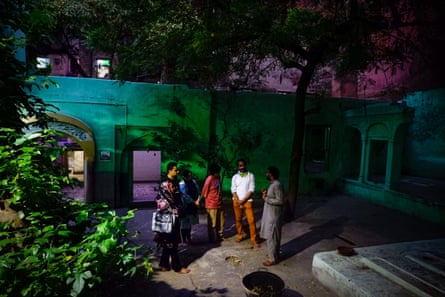On a hot and humid Sunday afternoon in Delhi, Iqbal Ali stops outside the Sultan Razia mosque and explains to the small group accompanying them why the place is so important to India’s LGBTQ+ community.
Ali recounts the story of Razia, the 13th-century ruler from the Mamluk dynasty, who wore male clothes, exuded strength and fearlessness and, alongside her father, Emperor Iltutmish, fought in numerous battles. She was the first female Muslim ruler of the subcontinent.
“While Emperor Iltutmish’s final resting place lies in the city’s famous Mehrauli Qutub Minar complex, our revered queer icon, Razia Sultan, rests in this forgotten neighbourhood of Old Delhi. Razia symbolises a queer icon for our community as she fearlessly challenged the patriarchal society that we, too, consider ourselves victims of,” says Ali.
Razia fully acclaimed, Ali then ushers the group along the road to the next stop of their walking tour of Delhi’s queer history.
Ali, a non-binary Muslim who was born and raised in Delhi, started the tours last year. Old Delhi, a walled district in the centre of the city, is a well-known tourist spot, but Ali wanted to shine a light on its forgotten or ignored history.
They offer three different tours, which take place once a month and last three hours; more than 2,500 people have participated so far.
This Sunday, starting at Lal Qila (Red Fort) metro station, Ali walks people through 800 years of Delhi’s queer history, from the Mamluk dynasty to the Mughal era and up to the present day, incorporating ancient sites and what were, before the emergence of internet dating sites, popular cruising spots.
“I consider this as a way of doing advocacy work for the queer community in the city,” they tell the Guardian between stops on the tour.
“My life has been shaped by my traumatic past and struggles where I have often felt displaced with my identity, self and being. This walking tour is a personal attempt for me to find myself, and find tranquillity.”
The group arrives at Sunehri Masjid (golden mosque), a majestic building constructed in the mid-18th century by Javed Khan, who belonged to the Khawaja Sara, or hijra – a term used to describe a transgender person.
They were often marginalised and relegated to menial work, but Khan, who was a eunuch, held enormous power. He was given the job of guarding Emperor Muhammad Shah’s harem, becoming a confidant of the women and a spy and close ally of the emperor.
Inside, Ali points to an inscription on the wall. “Although [it] does not mention the involvement of a queer person in its construction, take a closer look at the Persian writing,” they explain.
“It clearly indicates that it was indeed constructed by Khan. It is a proud moment for us.”

Sidra Qureshi, a bisexual Muslim woman from Delhi, says she had no idea these places that she has walked past so many times had such a rich history. “It is stories like these that engage and attract people like me to these walks,” says the 26-year-old history student.
“I find them a new way to look at Old Delhi and its culture. Old Delhi is a huge attraction for tourists for its Mughal history and delicious food, but queer history is ignored in popular historiography – it is hidden from tourists and Old Delhiites themselves.
“These walks give me a new area to think about my own surroundings,” she adds. “I feel my identity gets sharpened.”
Her partner calls the tours an act of rebellion because Muslims and queer people “face discrimination on a daily basis – so these walks are a way to claim the space”.
Shai, who wanted to be identified by first name only, says walking through Old Delhi with a queer lens is a treat. The 23-year-old student, from the eastern Indian state of Bihar, learned about the walks on Instagram.

Sipping tea during a pitstop at a bustling chai point, where milk boils all day, they say: “Having a queer Muslim leading this walk made me feel safe and empowered. I am aware of the vulnerability Muslims face in the current climate, but having the courage to be true to yourself in such times can inspire and empower fellow queers.”
As the sun begins to set, the tour reaches a narrow lane. Ali pauses. “Welcome to Mohalla Qabristan, also known as the graveyard neighbourhood,” they announce.
The lane leads to the Hijra Gharana, or transgender house, home to the caretakers of the historic Mehrauli Hijra graveyard, which dates back to the 15th century. Rows of unmarked white are found in Mehrauli, understood to be the final resting places of people from the transgender community.
Ali then leads the group to what they describe as the most important landmark of the walk, the shrine of Sarmad Kashani, a 17th-century Sufi mystic who, according to legend, took a young Hindu man called Abhay Chand as his lover.
Ali calls Kashani a “queer martyr”. He was beheaded for blasphemy.
Vishnu Nath, on the walking tour with his wife, Avantika Paul, says: “We have participated in many walks, but this one stands out. No one else covers so many hidden gems with such rich histories, especially the history of trans people, which is both important and often overlooked.

As the walk concludes at the famous Chandni Chowk market, tempting the crowds with treats such as crispy jalebi funnel cake, Ali says: “One of my main objectives is to educate people that our existence as a queer community is deeply intertwined with the historical events that have shaped the culture and people of this city for over a millennium.”
They hope the walks will help people see that homosexuality and transgender identities are inherent to Indian culture. “We have been repeatedly confronted with the claim that our identities are western propaganda. I want to say that we are not corrupted.”

